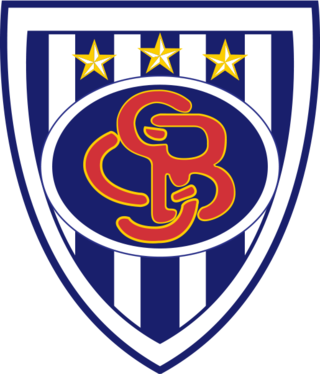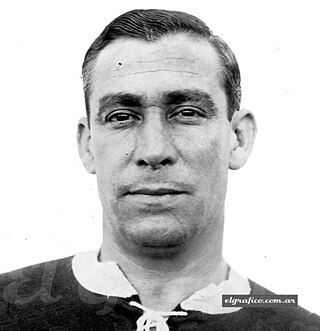
Club Atlético San Lorenzo de Almagro, commonly known as San Lorenzo de Almagro or simply San Lorenzo, is a sports club of Argentina in the Boedo district of Buenos Aires. It is best known for its football team, which plays in the Primera División, the first tier of the Argentinian football league system. San Lorenzo is also considered one of the "big five" of Argentinian football, along with Independiente, River Plate, Boca Juniors, and Racing Club.

Association football is the most popular sport in Argentina and part of the culture in the country. It is the one with the most players and is the most popular recreational sport, played from childhood into old age. The percentage of Argentines that declare allegiance to an Argentine football club is about 90%.

Club Atlético Huracán is an Argentine sports club from the Parque Patricios neighbourhood of Buenos Aires. The club is notable for its football team, that currently plays in the Primera División, the top level of the Argentine football league system. Its home stadium is the Estadio Tomás Adolfo Ducó.

Club Atlético Nueva Chicago is an Argentine sports club based in Mataderos, a neighborhood in the west side of Buenos Aires, formerly called "Nueva Chicago". The club's nickname, El Torito is an allusion to legendary 1930s boxer Justo Suárez, known as El Torito de Mataderos.
Primera B Metropolitana is one of two professional leagues that form the third level of the Argentine football league system. The division is made up of 17 clubs mainly from the city of Buenos Aires and its metropolitan area, Greater Buenos Aires.

Club Atlético Estudiantes, usually called Estudiantes de Caseros or Estudiantes de Buenos Aires, is an Argentine football club from Caseros, Buenos Aires. The club is mostly known for its football team, which currently plays in the Primera B Nacional, the second division of the Argentine football league system.
Club Atlético Talleres, usually called Talleres de Remedios de Escalada, is an Argentine sports club sited in the Remedios de Escalada district of Lanús Partido, Greater Buenos Aires. The club is mostly known for its football team, which currently plays in the Primera B Metropolitana, the third division of the Argentine football league system. The club also has a women's football section.

Club Sportivo Barracas is an Argentine sports club from Buenos Aires. The institution was born as a rowing club, nevertheless it is mostly known for its football activities nowadays. The team currently plays in Primera D Metropolitana, the fifth division of the Argentine football league system. The club has also a women's football section.

Manuel Seoane, nicknamed La Chancha, was an Argentine footballer who played as a striker for Independiente and Argentina national team.

Zoilo Canavery was an Uruguayan football player. Born in Montevideo, Canavery was a notable figure of Argentine sport during the 1910 and 1920 decades, playing in four of the "big five" of Argentina, such as Independiente, River Plate, Racing and Boca Juniors.

Alumni Athletic Club, or simply Alumni, was an Argentine football team active during the first years of the sport in that country. Although officially founded in 1898, the team had been formed in 1893 when a group of students from the Buenos Aires English High School joined Alexander Watson Hutton to form a team in order to participate in the championship organized by the Argentine Association Football League.
1922 in Argentine football saw Huracán win its second consecutive championship, while Independiente obtained its first title, the Asociación Amateurs de Football championship.
Club Sportivo Palermo was an Argentine football club that played in the Primera División during the 1920s. After being relegated in the 1930s and having played at lower divisions, the club was finally disbanded in the 1980s.
Club Sportivo Buenos Aires is a defunct Argentine football club from the city of Buenos Aires that played in Primera División during the 1920s.
Argentino Football Club de Banfield mostly known as Argentino de Banfield was an Argentine football club from the Banfield district of Greater Buenos Aires. The team played in Primera División during the 1920s and 1930s before merging with Club Atlético Temperley.
Club Sportivo Balcarce, or simply "Sportivo Balcarce", is an Argentine sports club located in Florida, Buenos Aires. Although other disciplines are held in the club, football was the most predominant sport while the senior squad was affiliated to the Argentine Football Association in the 1920s and 1930s.
Club Atlético Alvear was an Argentine football club affiliated to Argentine Football Association during the 1920s and 1930s. Alvear had its headquarters in Villa Crespo and its field in Saavedra, both districts of the city of Buenos Aires.
Club Honor y Patria was an Argentine football club sited in Bernal, Greater Buenos Aires. The institution was the first club from that city to have played in Primera División, the first level of Argentine football league system, although it lasted only one season in the division.
Club Progresista is an Argentine sports club based in the Piñeyro district of Avellaneda Partido, Greater Buenos Aires. The club has been regarded for its football squad that played in Primera División during the 1920s.
Club Sportivo Villa Urquiza was an Argentine football club located in the Villa Urquiza district of Buenos Aires. The club, founded in 1916, had a brief stint in the top division of Argentine football, Primera División, in mid 1920s, before merging to Club San Martín in 1925.









